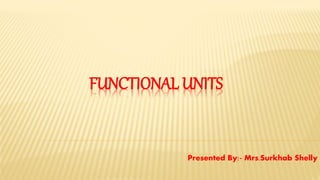
FUNCTIONAL UNIT
- 1. FUNCTIONAL UNITS Presented By:- Mrs.Surkhab Shelly
- 2. FUNCTIONAL UNITS Functional units of a computer system are parts of the CPU (Central Processing Unit) that performs the operations and calculations called for by the computer program. A computer consists of five main components namely, Input unit, Central Processing Unit, Memory unit Arithmetic & logical unit, Control unit and an Output unit. Input Unit This unit contains devices with the help of which we enter data into the computer. This unit creates a link between the user and the computer. The input devices translate the information into a form understandable by the computer.
- 3. CPU (CENTRAL PROCESSING UNIT) CPU is considered as the brain of the computer. CPU performs all types of data processing operations. It stores data, intermediate results, and instructions (program). It controls the operation of all parts of the computer. CPU itself has the following three components − ALU (Arithmetic Logic Unit) Memory Unit Control Unit
- 4. Control Unit This unit controls the operations of all parts of the computer but does not carry out any actual data processing operations. Functions of this unit are − •It is responsible for controlling the transfer of data and instructions among other units of a computer. •It manages and coordinates all the units of the computer. •It obtains the instructions from the memory, interprets them, and directs the operation of the computer. •It communicates with Input/Output devices for transfer of data or results from storage. •It does not process or store data.
- 5. ALU (Arithmetic Logic Unit) This unit consists of two subsections namely, •Arithmetic Section •Logic Section Arithmetic Section Function of arithmetic section is to perform arithmetic operations like addition, subtraction, multiplication, and division. All complex operations are done by making repetitive use of the above operations. Logic Section Function of logic section is to perform logic operations such as comparing, selecting, matching, and merging of data.
- 6. MEMORY UNIT The Memory unit can be referred to as the storage area in which programs are kept which are running, and that contains data needed by the running programs. The Memory unit can be categorized in two ways namely, primary memory and secondary memory. It enables a processor to access running execution applications and services that are temporarily stored in a specific memory location. Primary storage is the fastest memory that operates at electronic speeds. Primary memory contains a large number of semiconductor storage cells, capable of storing a bit of information. The word length of a computer is between 16-64 bits. It is also known as the volatile form of memory, means when the computer is shut down, anything contained in RAM is lost. Cache memory is also a kind of memory which is used to fetch the data very soon. They are highly coupled with the processor. Secondary memory is used when a large amount of data and programs have to be stored for a long-term basis. It is also known as the Non-volatile memory form of memory, means the data is stored permanently irrespective of shut down.
- 7. OUTPUT UNIT An output device is a piece of computer hardware that receives data from a computer and then translates that data into another form. That form may be audio, visual, textual, or hard copy such as a printed document. The key distinction between an input device and an output device is that an input device sends data to the computer, whereas an output device receives data from the computer.
- 8. INTERCONNECTION BETWEEN FUNCTIONAL COMPONENTS A computer consists of input unit that takes input, a CPU that processes the input and an output unit that produces output. All these devices communicate with each other through a common bus. A bus is a transmission path, made of a set of conducting wires over which data or information in the form of electric signals, is passed from one component to another in a computer. The bus can be of three types – Address bus, Data bus and Control Bus.
- 9. •The address bus carries the address location of the data or instruction. •The data bus carries data from one component to another and the control bus carries the control signals. •The system bus is the common communication path that carries signals to/from CPU, main memory and input/output devices. •The input/output devices communicate with the system bus through the controller circuit which helps in managing various input/output devices attached to the computer.
